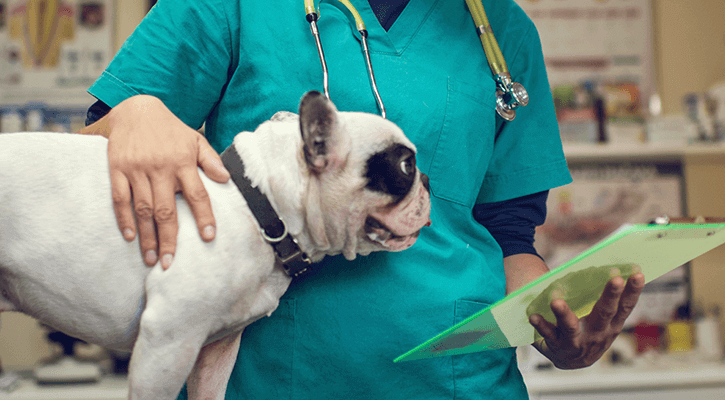
Surgery
It can be very upsetting for owners when your pet must undergo surgery. There can be several reasons that it may be necessary for them to undergo an operation, but any good veterinarian would not insist on surgery without adequate cause.
Reasons For Veterinary Sugery
Some reasons that your pet may require a surgical procedure include but are not limited to tooth extraction, growth removals/biopsies, foreign object removal, wound repair, torn ACL, and orthopedic fractures. For the majority of surgeries, it will be necessary for your pet to be put under general anesthesia.
What is Anesthesia?
There are two main types of anesthesia used in veterinary medicine. Local anesthesia provides pain relief for a specific location in the body, for example a nerve block before a tooth extraction. General anesthetic produces a state of unconsciousness which provides an absence of pain as well as complete muscular relaxation.
Sometimes pets require anesthesia to undergo examinations or testing such as x-rays which require them to remain calm and still. They may also require anesthesia for minor or major surgical procedures.
Is anesthesia safe for use on animals?
Like any medical procedure, anesthesia does carry a small risk. However, this is particularly low in otherwise healthy animals and your veterinarian will always give your pet a thorough examination prior to booking a procedure that requires an anesthetic, and in particular, a general anesthetic.
During the procedure your pet will be closely monitored, with their heart rate and breathing measure to ensure that his condition remains stable.
What to expect before a procedure at our hospital
Prior to any procedure, our team recommends sending off a pre-anesthetic blood panel. We recommend doing this a few days prior to surgery so we can ensure results are received before surgery day. This is to help minimize underlying risks before putting your pet under anesthesia. Even at a young age, there could be congenital problems that may put your pet at an increased risk. This panel will show us important values related to kidney and liver function – the organs that filter anesthesia out of the body – as well as reveal any blood clotting issues, which is important to know before a surgical procedure.
Upon intake, your pet will receive a thorough physical examination and an injection to prevent nausea, which can be common after anesthetic gas. Your pet will then receive their “happy drugs” as well as an injection for post-operative pain. The “happy drugs” have both an analgesic and a sedative effect. This way, your pet can be calm and comfortable during pre-operative preparations. An intravenous catheter will be placed in your pet’s forelimb to allow for quick IV access in the event of an emergency and for perioperative fluids. When it is time to perform the procedure, your pet will be induced with a sedative to allow access to the airway where an endotracheal tube will be secured for the passage of anesthetic gas and oxygen throughout the procedure. During the entire operation, your pet’s vitals will be closely monitored, recorded, and anesthesia adjusted as needed. Once complete, your pet will continue to be monitored until they have fully recovered. One of our veterinary nurses will contact you with an update on your pet’s condition. Our post-operative patients may spend one night in the hospital with us for continued monitoring, pain management, and an additional examination the morning after while others are performed as out-patient procedures.
Veterinary Surgery After Care
After your pet has had their operation, they will need specific care at home. We will send you home with post-operative care instructions. Surgical wounds should require little to no attention from you unless your veterinarian has advised you otherwise. However, you should check it daily and consult with your veterinarian if it is seen to be swelling, bleeding, or oozing. Your pet may have an extreme desire to lick at the wound and this should be discouraged as much as possible. Your veterinarian may have fitted your pet with a special collar to help prevent this.
If the removal of stitches is necessary, this will usually happen around 10-14 days after the operation and is done in a short, relatively painless procedure. Your veterinarian will advise if this is the case and Make An Appointment for your pet to have the stitches removed. Stitches must ALWAYS be removed by a qualified veterinarian, do not be tempted to try and do it yourself as this can cause damage and infection.
You should refrain from encouraging your pet to exercise for at least the first 48 hours following their operation. After this time exercise may still need to be limited depending on the type of surgery that your pet has had. Speak to your veterinarian who will be happy to advise you of a post-surgery exercise program for your pet.
Your pet may require medication to be administered for a period of time following their operation. When you are discharged, a nurse should go through the dosage information with you. It is vital that your pet completes the course of medication as prescribed.
Whatever surgery your pet has had, if you have any questions or concerns, never hesitate to contact us. We are happy to assist and advise you.
Schedule Veterinary Surgery in West Rome, GA
If you are considering surgery for your pet, please contact us at (706) 235-8861 to schedule a consultation or appointment with your West Rome Animal Clinic veterinarian or schedule an appointment online.
